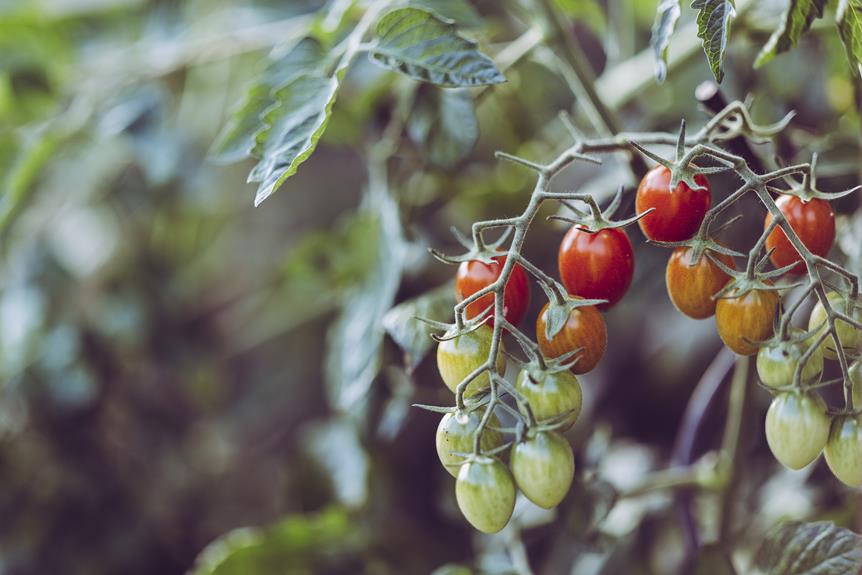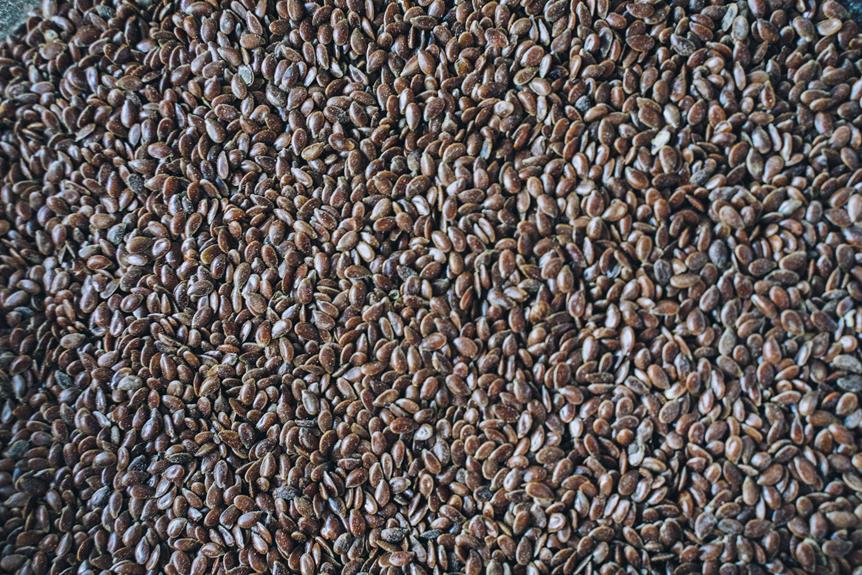Discover the 9 best benefits of crop rotation for your organic farming practices.
Increase soil fertility, control weeds and pests, prevent diseases, and cycle nutrients efficiently.
Improve soil structure, retain water effectively, and reduce erosion.
Embrace sustainable agricultural practices while enjoying enhanced biodiversity.
Crop rotation is the key to a successful organic farm.
Increased Soil Fertility
Increase your soil fertility with crop rotation. One of the key benefits of implementing crop rotation in your organic farming practices is the improved soil fertility it provides. By rotating different crops in your fields, you can enhance the quality of your soil, leading to healthier and more productive plants.
Crop rotation helps to break the cycle of pests and diseases that can plague specific crops. By alternating the types of plants you grow, you reduce the reliance on chemical pesticides and fertilizers, promoting a more sustainable and environmentally friendly approach to agriculture. This reduction in reliance on synthetic inputs not only benefits the health of your soil but also contributes to the overall health of your farm ecosystem.
Furthermore, crop rotation can help to replenish essential nutrients in the soil. Different crops have different nutrient requirements, and by rotating crops, you can ensure that the soil isn't depleted of specific nutrients. This helps to maintain a balanced nutrient profile, resulting in improved crop quality and higher yields.
Weed and Pest Control
To effectively manage weed and pest control in your organic farming practices, rely on the benefits of crop rotation. Crop rotation is an essential tool that can help you naturally control weeds and pests without relying on harmful chemicals. By rotating crops, you disrupt the life cycles of weeds and pests, making it harder for them to establish and multiply in your fields.
One of the key benefits of crop rotation for weed control is that it helps break the weed cycle. Different crops have different growth habits and nutrient requirements, which means they also have different weed pressures. By alternating crops, you can disrupt the weed life cycle and reduce the overall weed population in your fields. Additionally, some crops, such as legumes, have the ability to fix nitrogen in the soil, which can further suppress weed growth.
In terms of pest control, crop rotation works hand in hand with integrated pest management (IPM) strategies. IPM involves using a combination of natural methods to control pests, such as beneficial insects, trap crops, and crop diversification. By rotating crops, you create a less favorable environment for pests, making it harder for them to establish and spread. This can help reduce the need for chemical pesticides and promote a healthier ecosystem on your farm.
Disease Prevention
To effectively prevent diseases in your organic farming practices, implement crop rotation. Disease prevention is crucial for maintaining the health and productivity of your crops. By rotating your crops, you can break the disease cycle and reduce the risk of infections. Here are four reasons why crop rotation is an effective strategy for disease prevention:
- Disruption of disease cycles: Crop rotation helps to disrupt the life cycle of pests and pathogens. By planting different crops in a specific sequence, you can prevent the buildup of diseases that may affect a particular crop.
- Natural remedies: Certain crops have natural abilities to suppress diseases. By rotating these crops with susceptible ones, you can harness their natural abilities to control diseases in a sustainable manner.
- Enhanced soil health: Crop rotation helps to improve soil health, which in turn reduces the risk of diseases. Healthy soils promote beneficial microbial activity and nutrient availability, making plants more resistant to diseases.
- Biological control: Some crops attract beneficial insects and organisms that can combat pests and diseases. By rotating crops that attract these beneficial organisms, you can enhance biological control and reduce the need for chemical interventions.
Implementing crop rotation as part of your organic farming practices won't only prevent diseases but also promote a healthy and sustainable farming system.
Nutrient Cycling
To understand the importance of nutrient cycling in crop rotation, you need to know that it improves soil fertility and aids in disease and pest control.
By rotating crops, you're ensuring that different plants with varying nutrient needs are grown in the same area over time, which helps prevent nutrient depletion and promotes a balanced soil ecosystem.
This process also disrupts the life cycles of pests and diseases, reducing their impact on the crops.
Improved Soil Fertility
Crop rotation in organic farming provides numerous benefits, and one of the most significant is the improved soil fertility through efficient nutrient cycling. By implementing different crop rotation techniques and organic farming practices, you can enhance the health and productivity of your soil.
Here are four ways crop rotation improves soil fertility:
- Nutrient balance: Different crops have varying nutrient requirements. By rotating crops, you can balance the nutrient levels in the soil, preventing depletion and promoting overall soil health.
- Pest and disease control: Crop rotation disrupts the life cycles of pests and diseases, reducing their populations and minimizing the need for chemical interventions. This helps maintain the natural balance in the soil ecosystem.
- Weed suppression: Some crops naturally suppress weeds, while others are more susceptible to weed infestation. By rotating crops, you can reduce weed pressure, minimizing competition for nutrients and resources.
- Enhanced organic matter: Certain crops, such as legumes, fix nitrogen from the air and increase organic matter content in the soil. This promotes nutrient cycling and improves soil structure, moisture retention, and overall fertility.
Implementing crop rotation practices can lead to improved soil fertility, healthier plants, and increased yields, making it a valuable technique for organic farmers.
Disease and Pest Control
Rotate crops to control disease and pests while efficiently cycling nutrients in your organic farming practices.
Crop rotation is an effective method that helps break the life cycle of pathogens and pests, reducing their impact on your crops. By alternating different crops each season, you disrupt the continuous presence of specific pests and diseases that target a particular crop.
This reduces their ability to build up in the soil and minimizes the need for chemical interventions. Additionally, crop rotation promotes the growth of beneficial organisms, including natural predators, which can help control pests naturally.
By incorporating integrated pest management techniques, such as attracting beneficial insects or using trap crops, you can further enhance your disease and pest control efforts.
Improved Soil Structure
By implementing crop rotation on your organic farm, you can witness a significant improvement in the structure of your soil. This is possible due to the following reasons:
- Enhanced soil aeration: Crop rotation helps in breaking up compacted soil, allowing for better air circulation. This is crucial for the survival and growth of beneficial soil organisms, as well as for the overall health of your plants. Improved soil aeration also helps in the breakdown of organic matter, releasing nutrients for your crops.
- Increased root development: Different crops have varying root structures, with some plants having deep taproots while others have fibrous roots. By rotating crops, you provide an opportunity for different root types to penetrate different depths of the soil. This helps in breaking up soil compaction and improving soil structure over time.
- Promoted nutrient cycling: Crop rotation enables the diversification of crops, which in turn leads to a diverse range of nutrient requirements. This helps to prevent nutrient imbalances and promotes the efficient cycling of nutrients in the soil. As each crop takes up different nutrients from the soil, it also returns different nutrients when its residue decomposes, enriching the soil for subsequent crops.
- Reduced soil erosion: By rotating crops, you can effectively reduce soil erosion. Different crops have different root systems, some of which are more effective at holding soil in place. This helps to prevent erosion caused by wind and water, preserving the integrity of your soil structure.
Enhanced Water Retention
When it comes to crop rotation, one of the key benefits is enhanced water retention in the soil. By alternating crops, you can effectively manage soil moisture, allowing it to hold water for longer periods.
This increased water retention improves the overall drought resilience of your farm, ensuring that your crops have access to the water they need during dry spells.
Soil Moisture Management
Maximize your organic farming productivity by implementing crop rotation, which enhances water retention in the soil through effective soil moisture management. Here are four ways in which crop rotation helps with soil moisture management and water conservation:
- Reduced water runoff: Crop rotation helps to break up compacted soil and improve its structure, allowing the soil to absorb and retain water more effectively. This reduces the amount of water that runs off the surface, preventing soil erosion and conserving water.
- Efficient water use: Different crops have different water requirements. By rotating crops with varying water needs, you can optimize water usage and avoid over-irrigation. This helps to conserve water resources and promotes sustainable farming practices.
- Enhanced soil organic matter: Crop rotation involves the inclusion of cover crops, which contribute organic matter to the soil when they're incorporated. This organic matter improves soil structure and increases its water-holding capacity, allowing for better moisture retention.
- Reduced soil evaporation: When you rotate crops, you can choose crops with dense foliage that shade the soil surface, reducing evaporation. This helps to conserve soil moisture and ensure that water is available for plant uptake.
Increased Drought Resilience
To enhance water retention and increase drought resilience, organic farmers can benefit from crop rotation's ability to improve soil moisture management.
Drought management is a crucial aspect of sustainable agriculture, and crop rotation plays a vital role in mitigating its impact. By diversifying the crops in a field, organic farmers can minimize the risk of water scarcity during dry spells.
Different crop types have varying water requirements, and by rotating crops, farmers can optimize water usage and conserve this precious resource. Additionally, certain crops, such as legumes, have the ability to fix nitrogen and improve soil structure, further enhancing water retention.
This holistic approach to water conservation not only increases the resilience of organic farms in the face of drought but also contributes to the overall sustainability of the farming system.
Reduced Soil Erosion
By implementing crop rotation in your organic farming practices, you can significantly reduce soil erosion. This is one of the many benefits of crop rotation and is a key advantage of organic farming.
Here are four reasons why crop rotation helps to reduce soil erosion:
- Improved soil structure: Crop rotation involves alternating different crops in the same field over time. This helps to break up the soil and improve its structure, making it less prone to erosion by wind and water.
- Increased organic matter: Different crops have different root structures and nutrient requirements. By rotating crops, you can increase the organic matter content in the soil, which improves its ability to hold water and reduces the risk of erosion.
- Enhanced soil fertility: Crop rotation helps to balance the nutrient demands of different crops, reducing the need for synthetic fertilizers. This improves soil fertility and reduces erosion by promoting healthier plant growth.
- Weed control: Certain crops have natural weed-suppressing properties. By rotating crops, you can effectively control weeds without relying on chemical herbicides, which can contribute to soil erosion.
Increased Biodiversity
Promote greater biodiversity on your organic farm through crop rotation. By incorporating crop diversity into your farming practices, you can create an environment that supports a wide range of plant and animal species. Crop rotation involves planting different crops in a specific sequence over a period of time, which helps to break the cycle of pests and diseases that can affect a single crop. This not only improves soil health and fertility but also provides a habitat for beneficial insects, birds, and other wildlife.
Increasing biodiversity on your farm has several benefits. Firstly, it helps to maintain ecological balance by preventing the dominance of any single species. This balance is crucial for the overall health and sustainability of your farm ecosystem. Additionally, a diverse range of crops attracts a variety of pollinators, which are essential for the successful reproduction of many plants. This, in turn, leads to increased crop yields and better overall farm productivity.
Furthermore, increased biodiversity can enhance the resilience of your farm to environmental changes and natural disasters. Different crops have different tolerances to pests, diseases, and adverse weather conditions. By diversifying your crops, you're reducing the risk of a complete crop failure and ensuring a more stable income.
Sustainable Agricultural Practices
Incorporating sustainable agricultural practices is crucial for ensuring the long-term success and sustainability of your organic farming endeavors. By implementing regenerative agriculture techniques and embracing the principles of agroecology, you can't only enhance the health of your soil and crops but also contribute to food security on a larger scale.
Here are four important reasons why sustainable agricultural practices should be at the forefront of your organic farming approach:
- Regenerative agriculture: This approach focuses on restoring and enhancing the natural resources of your farm, such as soil health, water quality, and biodiversity. By adopting regenerative practices like cover cropping, composting, and crop rotation, you can improve soil fertility, reduce erosion, and minimize the need for synthetic inputs.
- Agroecology: This holistic approach emphasizes the interaction between ecological and social systems in agriculture. By promoting biodiversity, optimizing nutrient cycling, and enhancing ecosystem services, agroecology can help you achieve sustainable and resilient agricultural systems.
- Food security: Sustainable agricultural practices contribute to long-term food security by ensuring the availability and accessibility of nutritious food for present and future generations. By diversifying your crops and implementing sustainable practices, you can reduce the risk of crop failure, increase yields, and improve the nutritional value of your produce.
- Environmental stewardship: Sustainable agriculture practices help mitigate the negative impacts of conventional farming on the environment. By reducing chemical inputs, conserving water, and minimizing greenhouse gas emissions, you can contribute to the preservation of natural resources and the overall health of the planet.
Incorporating these sustainable agricultural practices won't only benefit your organic farm but also contribute to a more resilient and sustainable food system.




